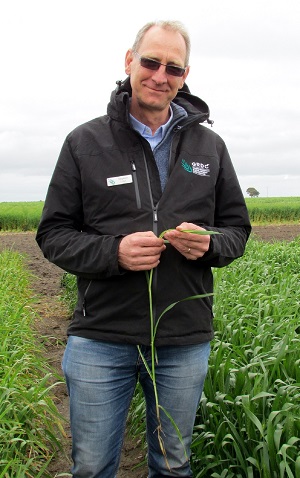Mixed farmers in low and medium rainfall zones across Australia’s southern and western regions will be the major beneficiaries of a significant new collaborative research initiative aimed at lifting average farm profit by 10 percent and halving farmers’ economic risk through the adoption of novel pasture legumes.

The Grains Research and Development Corporation (GRDC) is leading the $16 million project which is focused on delivering gains to mixed farming operations in Victoria, South Australia, southern New South Wales and Western Australia. This project is supported by funding from the Australian Government Department of Agriculture and Water Resources as part of its Rural R&D for Profit program.
The five-year project is also supported by Meat and Livestock Australia (MLA) and Australian Wool Innovation (AWI), and involves the South Australian Research and Development Institute, Murdoch University, the Commonwealth Scientific and Industrial Research Organisation, the WA Department of Primary Industries and Regional Development, and Charles Sturt University, as well as 10 grower groups.
The GRDC received more than $5.5 million through the Rural R&D for Profit program to invest in the project which will comprise five integrated programs of work: legume selection, cropping systems, livestock systems, economics and farm modelling, and extension.
GRDC Manager Soils and Nutrition – South, Dr Stephen Loss, says the project will develop recently discovered pasture legumes and innovative management techniques that benefit livestock and crop production and promote their adoption by mixed farmers.
“This project is designed to boost the resilience of mixed farms – through the successful incorporation of pasture legume species currently not widely grown – in areas where average annual rainfall is less than 400 millimetres,” Dr Loss said.
Among the benefits expected to flow from the project are increased livestock production and crop yields, improved whole farm business performance, enterprise flexibility, reduced inputs and enhanced resilience to frost, drought and variable prices. Plantings of legume pastures will add nitrogen to soils, improve soil structure, nutrient and water holding capacity and microbiological activity, and will provide valuable ground cover and protection from soil erosion.
Crop production benefits include greater nitrogen fixation, reduced fertiliser inputs to following crops, reduced reliance on herbicides to manage weed populations in the farming system due the grazing of weeds, and reduced disease and nematode prevalence in crops due to increased rotation with pastures.
Livestock production will benefit from better quality stock feed earlier in the season, improved animal reproduction and growth, and an ability to carry more livestock on each farm.
“The outcome we are striving towards is the adoption of 250,000 hectares of innovative legume pastures on mixed farms by 2022 and then increasing that to one million hectares by 2026 – boosting average farm profit by 10 percent and halving the risk of financial losses compared to intensively cropped farms,” Dr Loss said.
“The lack of diversity in farming systems – especially those under continuous cropping – and the absence of well adapted and innovative legumes are regularly rated as of high importance by growers and their advisers, especially in dry areas. This project has been activated in response to farmers’ needs.”
This issue originated many years ago from the GRDC Low Rainfall Regional Cropping Solutions Networks in the southern and western regions. The RCSNs are a collection of growers, advisers and industry representatives that identify key constraints or opportunities for farm businesses.
The Rural R&D for Profit project follows on from a pilot project with MLA and AWI in WA and southern NSW which demonstrated how novel pasture legumes can improve livestock production while reducing nitrogen requirements, weeds and diseases for following crops, increasing profit by $100-$200 per hectare.
Professor John Howieson from Murdoch University, who ran the pilot project and initiated the new Rural R&D for Profit project, said he was delighted the outcomes could now be transferred into new regions with a wider diversity of soils and challenges than those encountered in WA and NSW during the pilot.
Professor Howieson is leading the western component of the new project, while SARDI scientist Ross Ballard is leading the southern component.
Mr Ballard said the project would provide a real boost to pasture development for low and medium rainfall mixed farming areas. “It will provide growers with more and better pasture options for these environments,” he said.
“It provides a great opportunity to benchmark the performance of new legumes that are close to release. And also to have a look some different pasture species and what they might offer in terms of easy to harvest seed, ease of establishment and weed suppression.”
The full range of benefits provided by pastures are rarely measured, but through the new project these will be captured in several systems trials that measure their benefit to both livestock and crops.
Field experiments will be established throughout low-medium rainfall zones in SA, Victoria and WA. In addition to field work, research and development activities will occur in laboratories, animal houses and glasshouses in Perth and Adelaide.
At least 3500 farmers will be directly involved in research and extension activities during the project.
Dr Loss said a key strength of the project was the cohort of crop and animal researchers, modellers, extension specialists and grower groups which had been assembled to tackle the issues crucial to maximising farm profit and reducing risk in dry areas.
“This substantial program brings together for the first time scientists from across the country in a range of disciplines including pasture legume selection, rhizobiology, nitrogen fixation, pasture and crop agronomy, soil and plant nutrition, nitrogen mineralisation, weed management, feedbase production, animal production, and whole farm economics,” Dr Loss said.


